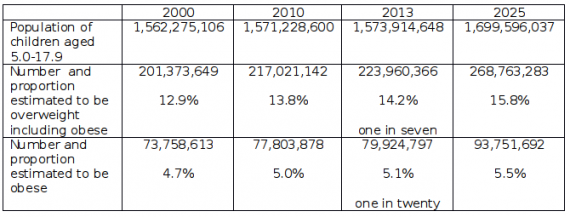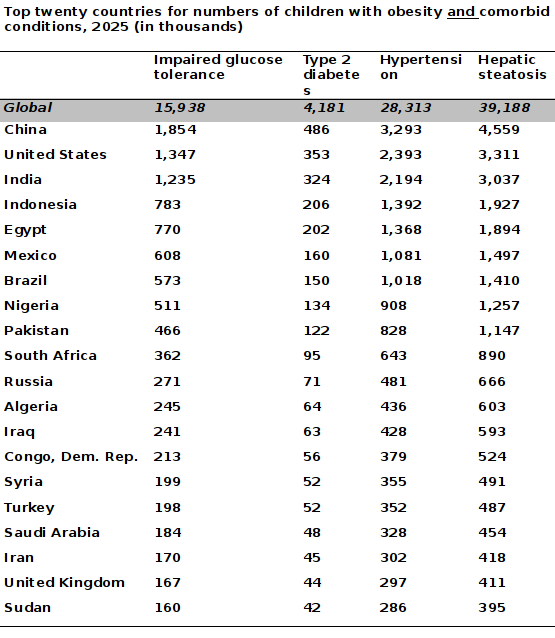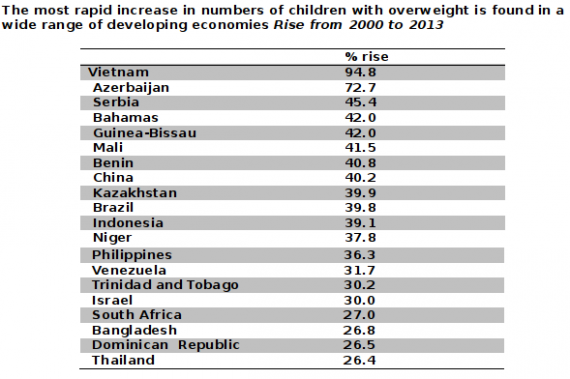220 million school-aged children (age 5.0 to 17.9 years) are overweight, and this will rise to 268 million by 2025 – of these 91 million will have obesity.
Approximately 80% of children who are overweight or obese live in low- and middle-income countries.
The WHO has published strong and comprehensive recommendations for actions that governments can take to end childhood obesity.
Governments are urged to fulfil their commitments and take bold and urgent action to halt the rise in child obesity.
World Obesity Day 2016 takes place on 11th October with a focus on ending childhood obesity.
New figures published by the World Obesity Federation in Pediatric Obesity [1] for World Obesity Day 2016 [3] suggest that if current trends continue, by 2025 some 268 million school-aged children (age 5.0 to 17.9 years) worldwide will suffer excess bodyweight [2] including 91 million who will have obesity. This is an increase from 223 million in 2013, and is in addition to the estimated 41 million children under age 5 years who are currently affected by overweight or obesity [2].
The data has been published to mark this year’s World Obesity Day [3] which takes place on the 11th October. This year the focus is on ‘ending childhood obesity’ with an emphasis on the need for urgent government action and leadership to tackle this unsustainable health concern.
In addition to rising levels of overweight and obesity, the analysis also suggests large numbers of children globally will be affected by obesity-related diseases by 2025 [1]. This includes up to 28 million with hypertension, 39 million with fatty liver disease, 15 million with impaired glucose tolerance and as many as 4 million with Type 2 diabetes, a disease which usually affects older age groups. (Note some children will have more than one condition.)
Perhaps of most concern is the fact that 80% of child overweight and obesity is expected to occur in low- and middle- income countries, where health systems will face rapid increases in demand for treating chronic diseases, and economic productivity will be reduced.
The President of the World Obesity Federation, Professor Ian Caterson from the Boden Institute at the University of Sydney, said “The obesity epidemic has reached virtually every country in the world, and overweight and obesity levels are continuing to rise in most places. It is of particular concern that it is the low- and middle- income countries who have the least resources to treat obesity are likely to have the greatest burden. Governments know the present childhood obesity epidemic is unsustainable and doing nothing is not an option. That’s why we are using World Obesity Day to call for urgent action.”
In the last ten years, consumption of sugary drinks worldwide increased by a third (33%) [4]. More than half of the world’s population now live in urban environments, while 80% of young people aged 11-17 fail to get sufficient physical activity [5].
In 2012 governments all around the world made a commitment to reduce the prevalence of young child and adolescent obesity to 2010 levels by the year 2025 [6]. In 2016 the governments of the World Health Assembly considered the report of the WHO Commission on Ending Childhood Obesity and resolved to develop national responses to implement the Commission’s recommendations [7]. The World Obesity Federation are using World Obesity Day, 11th October, to remind governments of their commitment and to call for them to take urgent action.
Dr Tim Lobstein, Director of Policy at the World Obesity Federation and author of the research commented “Soft drink and fatty food consumption have increased world-wide and children are becoming more sedentary. Junk food advertising continues to influence food choices, and increasing numbers of families live on low incomes in urban environments – a recipe for weight gain. Governments have pledged to reduce child and adolescent obesity to 2010 levels by the year 2025. Governments will utterly fail to meet this target unless they take strong action, including setting high standards for public sector food supplies, using public sector purchasing power, and introducing market interventions including taxation, labelling and advertising restrictions.”
As part of World Obesity Day [3], World Obesity Federation is also urging health ministries to introduce and expand screening, weight-loss, weight-management and treatment services to meet the needs of all children who are already overweight or obese. There is a need to improve the delivery of weight management and treatment services to ensure access for every person who needs them, children and adults alike. Medical services will need funding, staff will need training, and proper care pathways must be developed to ensure everyone has access to the care they need.
World Obesity Day will take place on 11 October 2016. This year the focus is on ending childhood obesity. For more information visit http://www.obesityday.worldobesity.org
References
[1] Lobstein, T & Jackson-Leach, R. Planning for the worst: estimates of obesity and comorbidities in school-age children in 2025. Pediatric Obesity, 11 (5), 321-325. Available to download here: http://onlinelibrary.wiley.com/doi/10.1111/ijpo.12185/full
[2] The figures have been calculated using the IOTF child cut-offs for thinness, overweight and obesity. See: Cole, TJ & Lobstein, T. Extended International (IOTF) body mass index cut offs for thinness, overweight and obesity. Pediatric Obesity. 2012, 7(4), 284-294: http://onlinelibrary.wiley.com/doi/10.1111/j.2047-6310.2012.00064.x/abstract;jsessionid=0C0F0F5AB254F70811D53663B91E028F.f01t01
[3] World Obesity Day will take place on 11 October 2016. This year the focus is on ending childhood obesity. For more information visit http://www.obesityday.worldobesity.org
Twitter: @worldobesity #WorldObesityDay
[4] Source: Euromonitor Passport and World Obesity Federation (2015)
[5] Source: World Health Organization and World Obesity Federation (2015)
[6] WHO (2014) Comprehensive implementation plan on maternal, infant and young child nutrition. See: http://www.who.int/nutrition/publications/CIP_document/en/
[7] WHO (2016) Report of the Commission on Ending Childhood Obesity. See: http://www.who.int/end-childhood-obesity/en/
Contact details:
Dr Tim Lobstein, Policy Director
World Obesity Federation
tlobstein@worldobesity.org
Ellie Needs, Head of Communications & Marketing
World Obesity Federation
Email: eneeds@worldobesity.org
Phone: +44 (0) 20 7685 2580
www.obesityday.worldobesity.org
Professor Ian Caterson, President, World Obesity Federation.
Email: ian.caterson@sydney.edu.au
Figures & Tables
Quelle: World Obesity Federation



